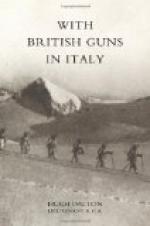It is a country with a strange beauty of its own; it is, in its own measure, rough and mountainous, and it is within sight of other and loftier mountains to the north-west. At my first view of it I remembered a speech of Carlo, the hero of Meredith’s Vittoria, concerning Lombard cities away on the other side of the Trentino, “Brescia under the big Eastern hill which throws a cloak on it at sunrise! Brescia is always the eagle’s nest that looks over Lombardy! And Bergamo! You know the terraces of Bergamo. Aren’t they like a morning sky? Dying there is not death; it’s flying into the dawn. You Romans envy us. You have no Alps, no crimson hills, nothing but old walls to look on while you fight. Farewell, Merthyr Powys....” To me those words were always recurring on the Italian Front. “Dying here is not death; it’s flying into the dawn.” I would have liked to have them engraved on my tombstone, if Fate had set one up for me in this land, whose beauty casts a spell on all one’s senses.
* * * * *
The Isonzo Front is divided into two parts by the Vippacco river, which flows roughly from east to west and joins the Isonzo at Peteano. Of these two parts the northern is three times as long as the southern. The northern part was held by the Italian Second Army, under General Capello, the southern by the Italian Third Army, under the Duke of Aosta. In the north the Isonzo runs through a deep ravine, with Monte Nero rising on its eastern side. Monte Nero is some 6800 feet high. The Alpini took it by a marvellous feat of mountain warfare in the first year of the war. South of Monte Nero, also on the east bank of the river, lies the town of Tolmino, the object of many fierce Italian assaults, but not yet taken. Here the Isonzo bends south-westward and continues to flow through a deep ravine past Canale and Plava, with the Bainsizza Plateau rising on its eastern bank. This Plateau is of a general height of about 2400 feet, and is continued south-eastward by the Ternova Plateau, rising to a general height of about 2200 feet. Bending again towards the south-east, the Isonzo flows out into the Plain of Gorizia. Here stand Monte Sabotino and Monte Santo, the western and eastern pillars of this gateway leading into the lower lands. East of Monte Santo, along the southern edge of the Plateau, stand Monte San Gabriele and Monte San Daniele. Here the Plateau falls precipitously down to the Vippacco valley, only the long brown foothill of San Marco breaking the drop.
Gorizia has scattered suburbs: Salcano to the north, in the very mouth of the gorge, the fashionable suburb in days before the war; Podgora to the west, on the other side of the Isonzo, industrial. The Isonzo Front was the only possible field for an Italian offensive on a great scale, and the possession of the Carso, of the Bainsizza and Ternova Plateaus and of Monte Nero are as essential to the future security of the Venetian Plain as the possession of the Trentino




